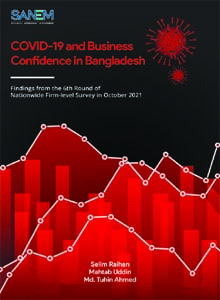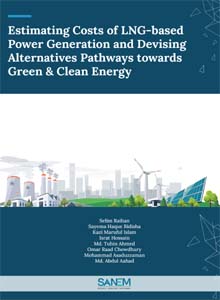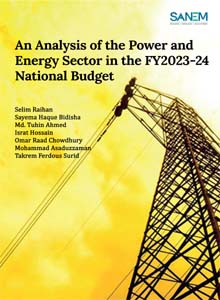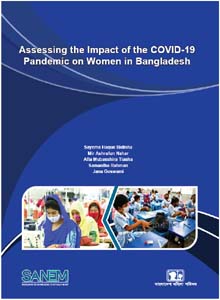
COVID-19 and Business Confidence in Bangladesh: Findings from the 6th Round of Nationwide Firm-level Survey in October 2021
 Citation: Raihan, S., Uddin, M., & Ahmed, M. T. (2021). COVID-19 and Business Confidence in Bangladesh: Findings from the 6th Round of Nationwide Firm-level Survey in October 2021. SANEM Publications, Dhaka, Bangladesh.
Citation: Raihan, S., Uddin, M., & Ahmed, M. T. (2021). COVID-19 and Business Confidence in Bangladesh: Findings from the 6th Round of Nationwide Firm-level Survey in October 2021. SANEM Publications, Dhaka, Bangladesh.
Abstract: COVID-19 had a tremendous economic impact on Bangladesh, especially in 2020, with massive business losses and closures, as well as an increase in unemployment and poverty. However, the effects of effective pandemic-related measures (lockdowns, social distancing, etc.) as well as government financial assistance contributed to reducing the number of cases and kicking-starting business recovery. Bangladesh is also handling things far better in terms of COVID-19 immunization, with a much higher percentage of citizens obtaining at least the first dose – a major contributor to the country’s rapid economic recovery. The government has already launched and disbursed stimulus packages to local businesses to support the recovery process. Furthermore, while vaccination progress was slow prior to the second wave, the government has lately been successful in negotiating with other countries for more vaccine doses, which is the first step toward the socio-economic situation returning to normal. The efficacy of government measures is dependent on close monitoring of the private sector – its issues and challenges – in order to update and implement better policies and financial assistance that are relevant to the business sector and the macroeconomy.
Against this backdrop, this study surveyed 500 firms across the country (255 manufacturing firms and 245 services sector firms). Based on Bangladesh’s most recent available National Accounts Statistics, seven sub-sectors in the manufacturing industry and eight sub-sectors in the services industry were identified. In the manufacturing sector, the study covers RMG, Textile, Pharmaceutical and Chemical, Leather & Tannery, Light Engineering, Food Processing, and so on. Wholesale, Retail, Restaurant, Transportation, ICT and Telecommunication, Financial Sector, Real Estate, and other services are covered from the services sector. The number of firms to be surveyed for each sub-sector was determined by the contribution of the sub-sectors to GDP.
This study develops four indices based on survey responses: (i) Present Business Status Index in July-September 2021 compared to April-June 2021, (ii) Present Business Status Index in July-September 2021 compared to July-September 2020, (iii) Business Confidence Index for October-December 2021 compared to July-September 2021, and (iv) Enabling Business-Environment Index for October-December 2021 compared to July-September 2021. (EBI). The indexes are created at the firm level initially and then aggregated at the sub-sectoral and sectoral levels with appropriate weights.
Over the last one and half years, there have been some visible recoveries of business activities. The improvement is visible in most of the sub-indicators of PBSI (year). For the very first time, the overall PBSI (year) has crossed the 50 mark, indicating business activities are improving. Faster recovery has been observed in Restaurant, RMG, Textile, and Light Engineering sectors amongst others while a year-on-year comparison is made.
Likewise, PBSI (quarter) has shown an improvement in business activities in the July-September 2021 quarter compared to April-June 2021 quarter. However, the overall PBSI (quarter) score is still low. The Restaurant sector, like the sectoral PBSI (year), has the highest score of 56.25, followed by Pharmaceutical & Chemical (54.97) and Textile (54.35).
The overall business confidence in October-December 2021 has improved compared to the July-September 2021 quarter. The improvement is visible for all sub-components of BCI. Sectors like Transport, Light Engineering, Tourism, Textile, RMG, and ICT amongst others have expressed greater confidence in the upcoming quarter, reflecting their optimism for better business prospects in near future.
Most of the time over the last one and half years, the business status and confidence were worse for micro, small and medium firms compared to large firms, non-exporter firms as opposed to exporter firms, firms from the services sector than manufacturing firms, and firms located outside Dhaka.
The overall EBI stagnated over the last two quarters. However, the EBIs of transport and government support improved during this period. It is observed that more than half of the sectors are below the overall score, although they are mostly above 50 or very close to it. The highest EBI score in this round belongs to Food Processing (56.32), despite a decrease from the previous round. In contrast, the lowest EBI score is held by the Restaurant sector, falling from 53.61 to 49.86.
46.2% of firms availed of any loan in the last 12 months. Amongst them, 77.5% availed from the formal sector (like banks) and 22.5% availed from informal sectors (like friends and relatives, cooperative society etc.). Completed paperwork, collateral problems, lengthy procedures, bank-client relationships etc. are the major problems for the firms to avail of any loan from the banks.
21% of respondents in the sixth round of the survey (July-September 2021) think that Bangladesh was on a path of strong recovery, while it was only 9% in the earlier round. Similarly, their views on moderate recovery increased to 52% in this round from 27% in the previous round.
Due to the second wave of the COVID-19, the business recovery rate went down to 34.9% in July 2021 (compared to March 2020) from 57.4% observed in April 2021 (compared to March 2020). However, the recovery rate increased to 56.8% in September 2021 (compared to March 2020) as the economy reopens at a full phase in the middle of the July-September 2021 quarter.
During July-September 2021, the major coping strategies of the firms involved using their own savings (71%). The other major strategies were borrowing (41%), stimulus package (18%), and employee lay-off (14%).
The coverage of vaccination for both employer and employee increased in July-September 2021 quarter compared to April-June 2021 quarter. The survey shows that 87% of respondents (employers) got at least one dose of the vaccine while the rate was 60% in the earlier round. In the case of employees’ vaccination, this figure was 55.07% in July-September 2021 quarter compared to 25.53% in the previous quarter.



